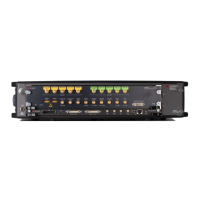will be two columns for idle samples i.e. Idle Samp. I and Idle Samp. Q.
Action ID
Allows selection of an action ID from the available list for configuration entries only.
The list displays the action IDs created in Action Table.
(Insert above)
Insert a new sequence entry row above the selected entry.
(Insert below)
Insert a new sequence entry row below the selected entry.
(Delete)
Delete the selected sequence entries.
(Cut)
Cut the selected sequence entries for pasting to another position in the present or
a new sequence. “Paste” option will be enabled.
(Copy)
Copy the selected sequence entries for pasting to another position in the present
or a new sequence. “Paste” option will be enabled.
(Paste)
Paste the copied or cut sequence entries to the target sequence entry.
(Clear Cut/Copy data)
Use this option to undo the cut or copy action. Once the option is clicked, data on
the clipboard will be erased, and the “Paste” option will be automatically disabled.
Action Table
The Action Table can be used to set NCO frequency and amplitude. There are also
separate frequency and amplitude tables to do the same. The action table can do a
lot more than setting frequency and amplitude, for example NCO phase or
continuous change of the NCO frequency (sweep).
Actions are more powerful but also more complex to use. You configure actions in
a configuration segment and they become active when the next sample marker in
the next segment is processed. If you only want to change NCO frequency or NCO
amplitude, it is easier to use frequency and amplitude table. Activation of a new
frequency or amplitude setting is done with one bit in the segment entry, no
sample marker necessary. If the set bit in the segment entry is detected by the
sequencer, the next frequency or amplitude entry in the table is activated in the
hardware.
Act.ID (Action ID)
Whenever a new action is created, it is automatically allocated a numeric ID
termed as Act.ID. First action has Act.ID as 1, second as 2, and so on.
New
More than one action can be allocated to an action ID. Use this option to mark any
of the existing actions as new. A new action will always have an action ID.

